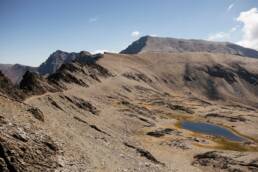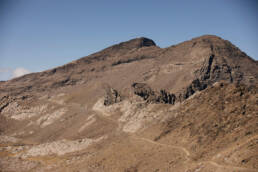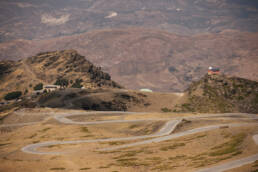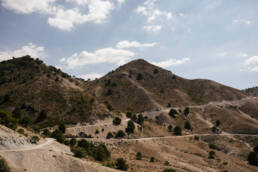Sierra Nevada (Sulayr for Muslims, the Mountain of the Sun) is a large mountain range that crosses the provinces of Granada and Almería, being the highest altitude system in Western Europe after the Alps, with a maximum elevation of 3.479m at the Mulhacén Peak.
The territory houses two types of natural areas, the National Park and the Natural Park that surrounds it.
At high altitudes, the relief is dominated by large hills that exceed 3.000m in altitude with some areas of perpetual snow, while at lower levels the landscape is steeper, with cliffs and ridges. In the eastern zone, gullies and ramblas shaped by sporadic but intense torrential rains predominate, giving way to another unique landscape of the territory, the Tabernas Desert.
Fauna and flora
The area boasts a rich biodiversity, sheltering over 2.100 plant species, including unique varieties like chamomile and yew. Oaks, holm oaks, and vast expanses of resin pines dominate the mid-mountain area, interspersed with walnuts and ancient chestnut trees. The diverse fauna comprises up to 2.000 arthropods, 300 of which are exclusive to the area, along with butterflies, mountain goats, golden eagles, and griffon vultures.




5 MINUTES WITH FRANCISCO DE ASÍS MUÑOZ,
DIRECTOR OF THE SIERRA NEVADA NATIONAL AND NATURAL PARK
Why is this Natural Area so special?
The Sierra Nevada mountain range in the Western Mediterranean boasts a remarkable diversity of plant and animal life, including Alpine, Boreoalpine, African, and Mediterranean species. Its altitude, proximity to the sea, and strategic location have created numerous environments that support this rich biodiversity.
The Sierra Nevada National Park plays a vital role in conserving the High Mediterranean Mountain ecosystems. As the largest and highest terrestrial National Park in Spain, it safeguards this unique and diverse natural heritage.
What corner of Sierra Nevada can’t we miss?
The Sierra Nevada boasts a multitude of special places, both natural and cultural, making it hard to choose just one. The deep ravines of the southern face with their traditional Alpujarran architecture and the High Mountain lagoons, remnants of Europe’s southernmost glaciers, are all must-see locations in the Sierra Nevada.
What positive impact do you think cycling can have on the territory?
Cycling can access lesser-known areas of Protected Areas, distributing the benefits of ecotourism and active tourism more widely and equitably. This increased accessibility generates wealth and opportunities for the surrounding communities.
On the other hand, what recommendations could we give to cyclists so that this impact does not conflict with the conservation of the territory itself?
When cycling in Sierra Nevada National Park, it’s crucial to remember that it’s only permitted on forest tracks to minimize environmental impact. Cyclists must be mindful of sharing these routes with hikers and adjust their speed accordingly, especially on slopes.
RECOMMENDED TOUR
REMEMBER THIS IS A PROTECTED AREA, PLEASE HAVE A LOOK TO THE ENVIRONMENTAL RECOMMENDATIONS
Sources: Andalucia.org / Juntadeandalucia.es / wikipedia.org